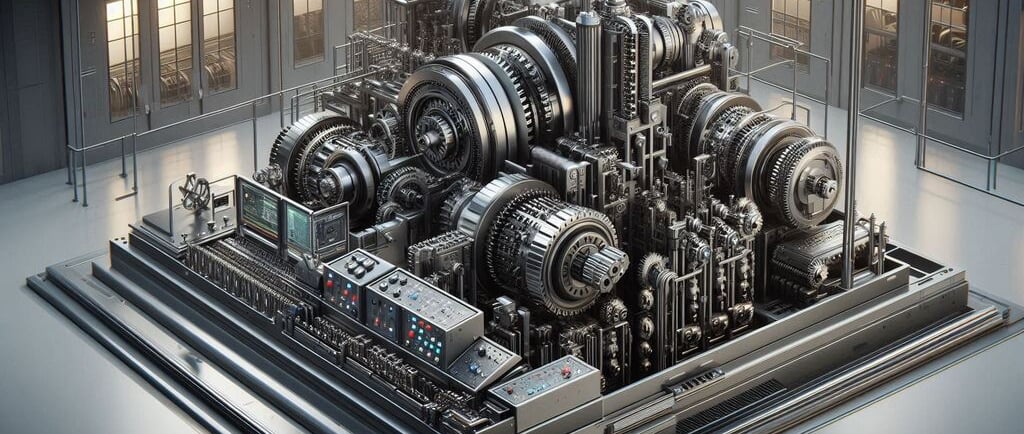Let us collaborate to foster global growth and development together.
Machinery & Equipment
Explore the key factors behind selecting the right machinery & equipment for your business. Learn how efficient tools improve productivity and optimize operations.
11/16/20074 min read


Explore the key factors behind selecting the right machinery & equipment for your business. Learn how efficient tools improve productivity and optimize operations.
Machinery & Equipment: Enhancing Efficiency and Productivity in Business Operations
Whether you're starting a new venture or scaling up an existing operation, selecting the right machinery and equipment is crucial to your business’s success. These tools are more than just assets; they represent the backbone of your operations, impacting your efficiency, productivity, and bottom line.
In this guide, we’ll walk you through the importance of choosing the right machinery and equipment for your business and offer actionable insights to make informed decisions.
Why Machinery & Equipment Matter
From manufacturing plants to warehouses and service providers, businesses rely heavily on machinery and equipment to ensure their operations run smoothly. Let’s explore why these resources are essential for modern businesses.
1. Increase Efficiency
One of the most significant benefits of investing in the right machinery is the boost in efficiency. Modern machines are designed to perform tasks faster and with more precision than manual labor. Whether it’s production lines that automate repetitive tasks or high-powered tools that provide greater output, using the proper machinery can drastically reduce time spent on various tasks.
Example: Automating the assembly line in a factory not only reduces human error but also speeds up production, allowing businesses to meet customer demand faster.
2. Improve Product Quality
Reliable machinery can lead to better-quality products by ensuring consistency and precision. When equipment is maintained well and designed to handle specific tasks, the output often meets high-quality standards that enhance customer satisfaction and reduce waste.
Example: In industries like food processing or textiles, having specialized machines can ensure products are manufactured with exact specifications, improving overall quality.
How to Choose the Right Machinery & Equipment for Your Business
Now that we understand why machinery and equipment are so essential, the next step is knowing how to choose the right ones for your business. Here are key factors to consider:
1. Evaluate Your Business Needs
Before purchasing machinery, assess your business's needs carefully. Is it high volume production? Do you require specific tools for precision? Understanding your requirements will help you select machinery that meets your operational goals.
Tip: Small businesses or startups may opt for equipment with lower upfront costs but scalability features to grow with their operations. Larger companies may invest in machines that handle high capacity with advanced technology.
2. Budget Wisely
While quality equipment may come at a premium, it’s important to balance your investment with your business's financial situation. You don’t have to purchase the most expensive models on the market. Look for equipment that offers a great value for your money but doesn’t compromise on essential features.
Example: If your business depends on logistics, you might want to prioritize equipment like forklifts or automated guided vehicles (AGVs) to enhance warehouse efficiency.
3. Consider Maintenance and Downtime
When machinery breaks down, production stops. Consider the reliability and durability of your equipment, as well as the manufacturer’s support. Look for machinery with a strong warranty and after-sales support, including easy access to replacement parts.
Tip: Implement regular maintenance schedules and ensure your operators are trained to handle routine troubleshooting to minimize costly downtime.
Popular Types of Machinery & Equipment Across Industries
Each industry has its unique machinery needs. Let’s explore some of the most common machinery and equipment used across various sectors.
1. Manufacturing Equipment
Manufacturing processes require robust machinery designed for repetitive tasks. Key equipment used in manufacturing includes:
CNC Machines (Computer Numerical Control): These machines are essential for industries requiring high precision, such as metalworking and woodworking.
Injection Molding Machines: Common in the plastics industry, these machines are used to produce intricate and mass-producible items like plastic containers or automotive components.
Packaging Machines: Used in various industries to package goods efficiently.
2. Construction Equipment
The construction industry relies heavily on heavy machinery to carry out tasks like excavation, material handling, and more. Some top construction equipment includes:
Excavators: For digging and trenching.
Bulldozers: For moving large quantities of soil or rubble.
Cranes: Used to lift heavy materials to higher levels at construction sites.
3. Agricultural Equipment
Farming and agriculture have become increasingly automated with specialized machinery aimed at improving crop yields and efficiency. Key agricultural equipment includes:
Tractors: Vital for planting, plowing, and harvesting.
Combine Harvesters: Used to harvest grain crops effectively.
4. Service Industry Equipment
Restaurants, healthcare providers, and hospitality businesses also rely on specific types of machinery and equipment:
Point of Sale (POS) Systems: Integral for streamlining customer transactions.
Medical Equipment: For diagnostic and therapeutic treatments.
Food Processing Machines: For tasks such as cutting, grinding, and preparing food at high volumes.
Best Practices for Machinery and Equipment Management
To ensure that your machinery and equipment continue to perform efficiently, here are some management practices to follow:
1. Proper Training
Investing in training for your operators will significantly reduce the risk of accidents and mishandling of equipment. Proper training also ensures that machinery is used efficiently, maximizing its lifespan.
2. Regular Inspections
Conduct routine checks to identify potential issues before they lead to costly repairs. Proactive inspections help keep your equipment in good working condition, ultimately preventing downtimes.
3. Data Tracking
With modern machinery and equipment becoming increasingly digital, consider utilizing data tracking systems. These systems can offer valuable insights into how your equipment performs, highlighting potential areas of improvement.
Conclusion: Equip Your Business for Success
Choosing the right machinery and equipment is more than just a one-time purchase—it's an investment that plays a critical role in the success of your business. Proper machinery can not only increase production efficiency but also improve product quality, reduce operational costs, and elevate customer satisfaction.
By considering your business’s needs, budget, and ongoing maintenance, you can make more informed purchasing decisions. Make sure to explore all options available to select equipment that is both scalable and cost-effective. Don’t forget to create a robust system for proper management and maintenance to keep your operations running smoothly.
Have you recently upgraded your business’s machinery? Share your experiences and tips in the comments below!
Innovation
Cutting-edge solutions for industrial efficiency and productivity.
© 2024. All rights reserved.


